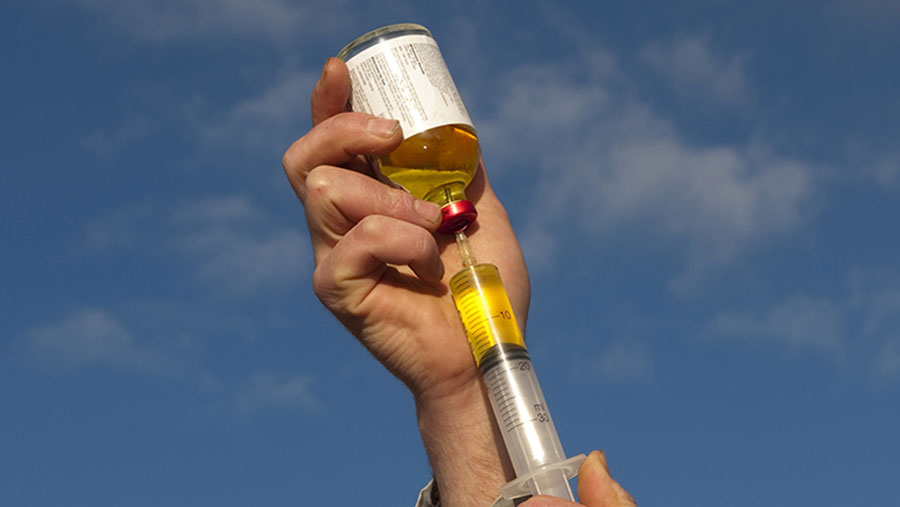Review finds 11 barriers to reducing on-farm antibiotics
 © FLPA/REX/Shutterstock
© FLPA/REX/Shutterstock There are challenges and opportunities for the reduction of antibiotics use on farm, a review of several studies has found.
Academics analysed the findings of 48 peer-reviewed journals between 2000 and 2016 to investigate what is understood about the use of antimicrobials in animals reared for food production.
The papers were mainly from production systems in Europe and the US.
See also: 2020 target to stop using critically important antibiotics
The review outlined 11 key barriers to reducing antimicrobials in farming. These are:
- The inflexibility of production systems Systems requiring feeding, in-water or treatment of all youngstock at a certain key age such as weaning or housing.
- Low capacity for reinvestment in farm buildings Meaningful adaptations are time-consuming and expensive.
- High production costs Low margins mean little money to spend on improvements and changes.
- A “good farmer” mindset treating stock with double doses or longer courses in the belief this helps the animal.
- Welfare concerns Animal welfare is a priority and farmers hate to see stock unwell. For example, a few coughing calves means all might be treated to nip the issue in the bud.
- Failure to follow treatment guidelines Using many or not enough antimicrobials as old bottles are stretched or in-feed or in-water medication is not being adequately dosed due to differing intakes.
- The belief antimicrobial use will improve profits Another mindset issue linking antimicrobials to strong efficacy in dealing with disease but also in antibiotics growth promotion, which has been outlawed in the EU since 2006.
- Veterinary pressure A feeing by veterinarians farmers and feed suppliers are pressuring them to use antimicrobials. A quick solution and cure is often needed, hence the view antimicrobials are the best recourse.
- Changing regimes Switching from in-feed to in-water has been a trend in the pig sector over the past 10 years could be increasing antimicrobials consumption
- Not advised Farmers treat animals with antimicrobials without veterinary recommendation first.
- Belief in prophylaxis Believing blanket use is justifiable and prudent, such as with dry cow therapy on all cows or treating all lambs in the lambing shed.
Inflexibility of systems
Kristen Reyher, University of Bristol’s school of veterinary sciences, explained inflexible systems might be those requiring animals to be treated as a group, by putting medication in feed or water or treating entire pens, rather than allowing animals to be treated individually after diagnosis.
“Some of these decisions are based around mindset and an ability to think outside the box and change routines and practices would be helpful,” she told Farmers Weekly. “Better diagnostics, biosecurity and innovation generally can help here.”
Buildings
Investing in farm buildings represented a major cost and a long-term change and a complete system overhaul, explained Dr Reyher.
“Systems in place for many years can be difficult to change and can only be tweaked rather than overhauled to allow for substantial changes,” she said.
Adaptations might include automating temperature management with fans and windows to optimise conditions and reduce the risk of illness, slatted floors to improve hygiene, wider alleys and buildings to allow efficient automated cleaning.
High costs
Many farms struggle against the high costs of production and narrow margins which fundamentally limit spending on new health programmes, infrastructure and advice.
Dr Reyher added: “Farmers are already squeezed by the markets, making it really difficult to invest in long-term improvements.
“Methods for reducing cost of production as much as possible would free up more money that could then be reinvested.”
The rapid evidence assessment (REA)
The REA, led by Henry Buller, University of Exeter and Dr Reyher, was designed to summarise published evidence around the agriculture industry’s views on antimicrobials use on farms.
Dr Reyher said: “The REA highlights the potential role not only of farmers and veterinarians but also of other advisers, public pressures and legislation to influence change in the use of antimicrobials in livestock and to improve the system of farming for the benefit of all animals and humanity.”
The REA has also identified a number of “positive drivers” towards reduced use of antimicrobials on farms.
These were:
- Wider use of diagnostics: finding out what the specific health issue is
- Wider use of vaccines: reducing disease and removing the need for antimicrobial treatment
- Higher levels of on-farm biosecurity – removing the chances for pathogens to come onto the farm
- New knowledge exchange methods
- Improving awareness of responsible antimicrobials use
